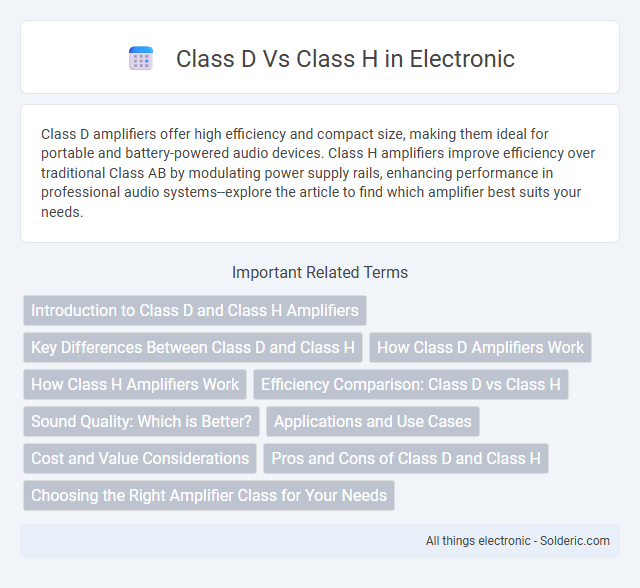Class D amplifiers offer high efficiency and compact size, making them ideal for portable and battery-powered audio devices. Class H amplifiers improve efficiency over traditional Class AB by modulating power supply rails, enhancing performance in professional audio systems--explore the article to find which amplifier best suits your needs.
Comparison Table
| Feature | Class D Amplifier | Class H Amplifier |
|---|---|---|
| Operation | Switching amplifier using pulse-width modulation (PWM) | Linear amplifier with dynamic power supply rails |
| Efficiency | Up to 90-95% | 70-85%, improved over Class AB |
| Heat Dissipation | Low heat generation | Moderate heat generation |
| Sound Quality | Good, with potential switching noise | Very good, high fidelity |
| Applications | Portable speakers, subwoofers, battery-powered devices | High-end audio, professional sound systems |
| Complexity | Relatively simple, fewer components | More complex due to rail tracking circuitry |
| Cost | Lower cost | Higher cost |
Introduction to Class D and Class H Amplifiers
Class D amplifiers utilize pulse-width modulation to achieve high efficiency and compact design, making them ideal for portable and battery-powered devices. Class H amplifiers improve efficiency by dynamically adjusting the power supply voltage in response to the input signal, reducing power loss and heat generation. Understanding these technologies helps you choose the right amplifier based on performance needs and application constraints.
Key Differences Between Class D and Class H
Class D amplifiers utilize pulse-width modulation or switching technology for high efficiency, generating less heat and providing compact designs, whereas Class H amplifiers employ rail switching with multiple power supply rails to improve efficiency and reduce power loss. Class D offers efficiencies typically above 90%, making it ideal for portable and battery-powered applications, while Class H achieves better linearity and lower distortion than Class AB by dynamically adjusting the voltage rails. Key differences lie in their operational principles, with Class D focusing on switching amplification and Class H emphasizing power supply modulation for improved performance in high-power audio amplification.
How Class D Amplifiers Work
Class D amplifiers operate by rapidly switching transistors on and off, converting the input signal into a high-frequency pulse-width modulated (PWM) waveform. This efficient switching minimizes power loss and heat generation, making Class D amplifiers ideal for portable and high-power audio applications. Understanding how your Class D amplifier works helps optimize performance and energy use in your audio setup.
How Class H Amplifiers Work
Class H amplifiers improve efficiency by dynamically modulating the power supply rails according to the input signal's amplitude, reducing wasted energy during lower output levels. Unlike Class D amplifiers that use pulse-width modulation for amplification, Class H uses multiple voltage rails and switches between them to maintain high fidelity while minimizing heat dissipation. Understanding how Class H amplifiers work helps you optimize audio systems for both performance and energy efficiency.
Efficiency Comparison: Class D vs Class H
Class D amplifiers deliver efficiency rates typically between 80% and 90% due to their switching operation, minimizing power loss and heat generation. Class H amplifiers improve on traditional Class AB designs by dynamically adjusting power supply rails, achieving efficiencies around 70% to 80%. Your choice depends on whether maximum efficiency or audio fidelity with moderate power savings better suits your application.
Sound Quality: Which is Better?
Class H amplifiers generally offer superior sound quality compared to Class D due to their ability to deliver cleaner and more accurate audio signals with lower distortion and noise levels. Class D amplifiers, while highly efficient and compact, often introduce more switching noise and less linearity, which can affect the clarity and fidelity of sound reproduction. Audiophiles and professional audio applications typically favor Class H designs for high-fidelity performance and dynamic range.
Applications and Use Cases
Class D amplifiers excel in portable and battery-powered devices due to their high efficiency and compact size, making them ideal for smartphones, Bluetooth speakers, and car audio systems. Class H amplifiers, with improved power efficiency and enhanced thermal management, are widely used in professional audio equipment, concert sound systems, and high-power public address systems. Your choice depends on whether you prioritize energy efficiency and size or require robust performance for high-power, large-scale audio applications.
Cost and Value Considerations
Class D amplifiers are generally more cost-effective due to their high efficiency, leading to lower power consumption and less heat dissipation, which reduces the need for expensive cooling solutions. Class H amplifiers, although pricier, offer improved audio quality by dynamically adjusting power supply rails, providing better performance in demanding audio applications. Choosing between Class D and Class H depends on budget constraints and the value placed on efficiency versus audio fidelity in specific use cases.
Pros and Cons of Class D and Class H
Class D amplifiers offer high efficiency up to 90% and compact size, making them ideal for portable and battery-powered devices, but they may introduce more signal distortion and electromagnetic interference compared to analog designs. Class H amplifiers improve efficiency by dynamically adjusting power supply rails, resulting in better sound quality and lower heat dissipation than Class AB amps, yet they are more complex and typically larger and costlier than Class D amplifiers. Choosing between Class D and Class H depends on priorities such as efficiency, sound fidelity, size, and budget constraints.
Choosing the Right Amplifier Class for Your Needs
Class D amplifiers offer high efficiency and compact size, making them ideal for portable and energy-conscious applications. Class H amplifiers provide improved linearity and reduced distortion, suitable for professional audio systems requiring superior sound quality. Evaluating your audio performance needs and power efficiency priorities will guide you in choosing the right amplifier class.
Class D vs Class H Infographic

 solderic.com
solderic.com